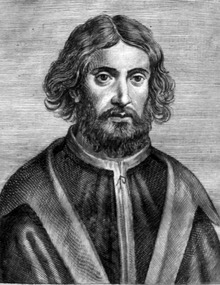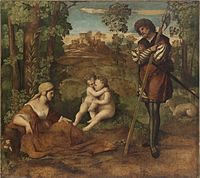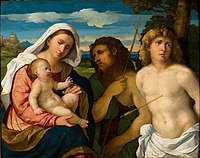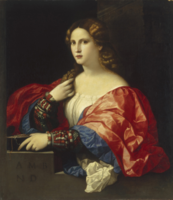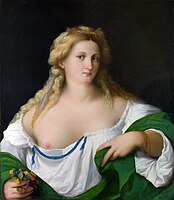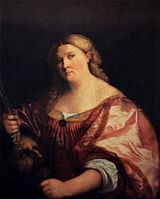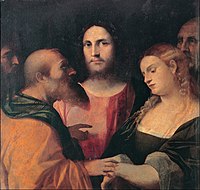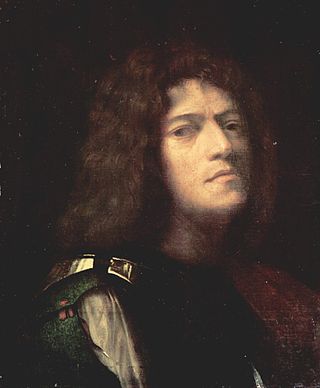
Giorgio Barbarelli da Castelfranco, known as Giorgione, was an Italian painter of the Venetian school during the High Renaissance, who died in his thirties. He is known for the elusive poetic quality of his work, though only about six surviving paintings are firmly attributed to him. The uncertainty surrounding the identity and meaning of his work has made Giorgione one of the most mysterious figures in European art.

Tiziano Vecellio, Latinized as Titianus, hence known in English as Titian, was an Italian Renaissance painter, the most important artist of Renaissance Venetian painting. He was born in Pieve di Cadore, near Belluno. During his lifetime he was often called da Cadore, 'from Cadore', taken from his native region.

Giovanni Bellini was an Italian Renaissance painter, probably the best known of the Bellini family of Venetian painters. He was raised in the household of Jacopo Bellini, formerly thought to have been his father, but now that familial generational relationship is questioned. An older brother, Gentile Bellini was more highly regarded than Giovanni during his lifetime, but the reverse is true today. His brother-in-law was Andrea Mantegna.

Lorenzo Lotto was an Italian Renaissance painter, draughtsman, and illustrator, traditionally placed in the Venetian school, though much of his career was spent in other north Italian cities. He painted mainly altarpieces, religious subjects and portraits. He was active during the High Renaissance and the first half of the Mannerist period, but his work maintained a generally similar High Renaissance style throughout his career, although his nervous and eccentric posings and distortions represented a transitional stage to the Florentine and Roman Mannerists.

Alessandro Bonvicino, more commonly known as Moretto, or in Italian Il Moretto da Brescia, was an Italian Renaissance painter from Brescia, where he also mostly worked. His dated works span the period from 1524 to 1554, but he was already described as a master in 1516. He was mainly a painter of altarpieces that tend towards sedateness, mostly for churches in and around Brescia, but also in Bergamo, Milan, Verona, and Asola; many remain in the churches they were painted for. The majority of these are on canvas, but a considerable number, including some large pieces, are created on wood panels. There are only a few surviving drawings from the artist.

Sebastiano del Piombo was an Italian painter of the High Renaissance and early Mannerist periods famous as the only major artist of the period to combine the colouring of the Venetian school in which he was trained with the monumental forms of the Roman school. He belongs both to the painting school of his native city, Venice, where he made significant contributions before he left for Rome in 1511, and that of Rome, where he stayed for the rest of his life, and whose style he thoroughly adopted.

Paris Bordone was an Italian painter of the Venetian Renaissance who, despite training with Titian, maintained a strand of Mannerist complexity and provincial vigor.
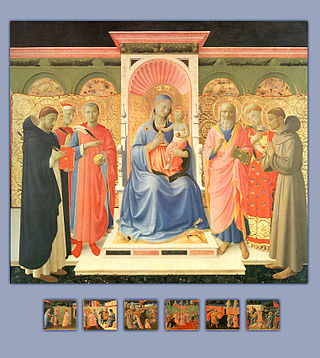
In art, a sacra conversazione, meaning "holy conversation", is a genre developed in Italian Renaissance painting, with a depiction of the Virgin and Child amidst a group of saints in a relatively informal grouping, as opposed to the more rigid and hierarchical compositions of earlier periods. Donor portraits may also be included, generally kneeling, often their patron saint is presenting them to the Virgin, and angels are frequently in attendance.

Bonifazio Veronese, born Bonifazio de' Pitati, was a Venetian Renaissance painter who was active in the Venetian Republic. His work had an important influence on the younger generation of painters in Venice, particularly Andrea Schiavone and Jacopo Tintoretto.
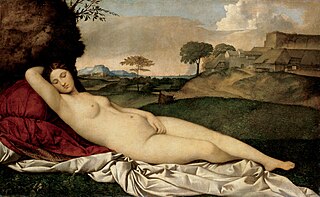
The Sleeping Venus, also known as the Dresden Venus, is a painting traditionally attributed to the Italian Renaissance painter Giorgione, although it has long been widely thought that Titian completed it after Giorgione's death in 1510. The landscape and sky are generally accepted to be mainly by Titian. In the 21st century, much scholarly opinion has shifted further, to see the nude figure of Venus as also painted by Titian, leaving Giorgione's contribution uncertain. It is in the Gemäldegalerie, Dresden. After World War II, the painting was briefly in possession of the Soviet Union.
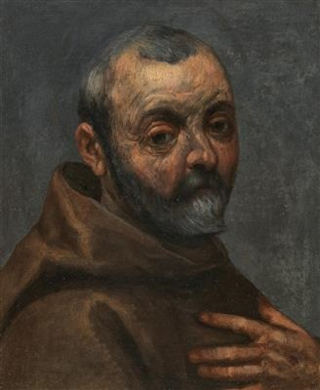
Iacopo Negretti, best known as Jacopo or Giacomo Palma il Giovane or simply Palma Giovane, was an Italian painter from Venice and a notable exponent of the Venetian school.

Giovanni Cariani, also known as Giovanni Busi or Il Cariani, was an Italian painter of the high-Renaissance, active in Venice and the Venetian mainland, including Bergamo, thought to be his native city.

The Assumption of the Virgin or Frari Assumption, popularly known as the Assunta, is a large altarpiece panel painting in oils by the Italian Renaissance artist Titian, painted in 1515–1518. It remains in the position it was designed for, on the high altar of the Basilica di Santa Maria Gloriosa dei Frari or Frari church in Venice. It is the largest altarpiece in the city, with the figures well over life-size, necessitated by the large church, with a considerable distance between the altar and the congregation. The images above and below are not Titian's work, they are by Palma Vecchio.

Venetian painting was a major force in Italian Renaissance painting and beyond. Beginning with the work of Giovanni Bellini and his brother Gentile Bellini and their workshops, the major artists of the Venetian school included Giorgione, Titian, Tintoretto (1518–1594), Paolo Veronese (1528–1588) and Jacopo Bassano (1510–1592) and his sons. Considered to give primacy to colour over line, the tradition of the Venetian school contrasted with the Mannerism prevalent in the rest of Italy. The Venetian style exerted great influence upon the subsequent development of Western painting.

A Man with a Quilted Sleeve is a painting of about 1510 by the Venetian painter Titian in the National Gallery, London, measuring 81.2 by 66.3 centimetres. Though the quality of the painting has always been praised, there has been much discussion as to the identity of the sitter. It was long thought to be a portrait of Ariosto, then a self-portrait, but since 2017 has been called Portrait of Gerolamo (?) Barbarigo by the gallery, having also been called merely Portrait of a Man, the title used here, The Man with the Blue Sleeve, and no doubt other variants.

Pietro degli Ingannati, also Pellegrino di Giovanni di Antonio, was an Italian Renaissance painter who is known for his paintings of the Virgin and Child and his portraits.

The Adoration of the Shepherds by Giovanni Cariani is a panel painting of about 1515-1517, now in the Royal Collection of the United Kingdom. The painting is somewhat damaged, and also seems to have been subject to significant changes of intention during the process of painting. It was one of the large group of paintings bought by Charles I of England from the collection of Vincenzo II, last of the Gonzaga Dukes of Mantua in 1628. The painted surface measures 73.6 cm × 120.3 cm.

Madonna and Child with Saints is a c. 1520 oil on panel painting by Palma Vecchio, now in room XVI of the Accademia Carrara in Bergamo, the artist's birthplace. It is first recorded as part of the collection of Guglielmo Lochis, who acquired it in 1830 from Cristoforo Orsetti, one of the most important Venetian collectors of that era.
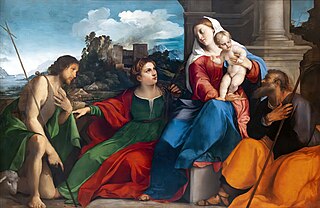
Holy Family with Saint John the Baptist and Saint Catherine is a c. 1520-1528 oil on canvas painting by Palma Vecchio, now in the Gallerie dell'Accademia in Venice. It was completed by Titian after Palma's death.

A Blonde Woman, also called Flora, is an oil painting by Palma Vecchio, dated today to around 1520, but undocumented before 1870, in the collection of the National Gallery, London.
